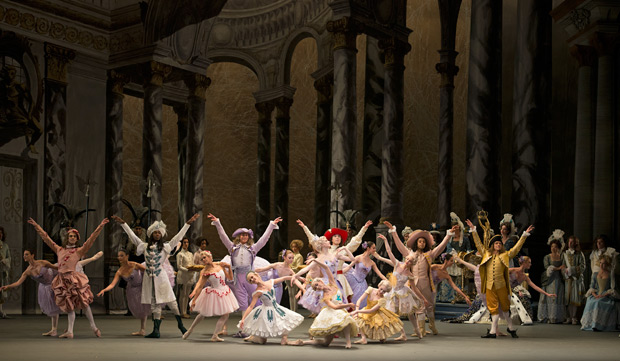
© Gene Schiavone. (Click image for larger version)
American Ballet Theatre
The Sleeping Beauty
Washington, Kennedy Center Opera House
★★★★✰
27, 28 January 2016
www.abt.org
www.kennedy-center.org
American Ballet Theatre’s The Sleeping Beauty made its much-anticipated visit to Washington D.C. for a seven-performance engagement at the Kennedy Opera House in January. This brand new staging of the famous 19th-century classic was created last year by Alexei Ratmansky, artist-in-residence of the company, to commemorate ABT’s 75th anniversary season.
Although only in its first year, this Sleeping Beauty is well-traveled. The ballet was premiered by ABT at the Segerstrom Center for the Arts in Costa Mesa, California, in March, was the highlight of ABT’s spring season at the Metropolitan Opera House in New York and in the fall, was performed in Milan by the ballet troupe of Teatro alla Scala, which co-produced this Sleeping Beauty with ABT and shared the production’s six-million-dollar price tag.
Ratmansky’s new staging is a Beauty like you have never seen before: it uncovers the original ballet’s genuine beauty, which faded over the years under the clutter of modern revisions. This production offers a unique chance to admire anew the genius of Marius Petipa, the great ballet master who created The Sleeping Beauty for St. Petersburg’s Mariinsky Ballet in 1890. If you have ever wondered what Petipa’s choreography looked like before it was dubbed “after Petipa,” Ratmansky’s Beauty holds the answer.
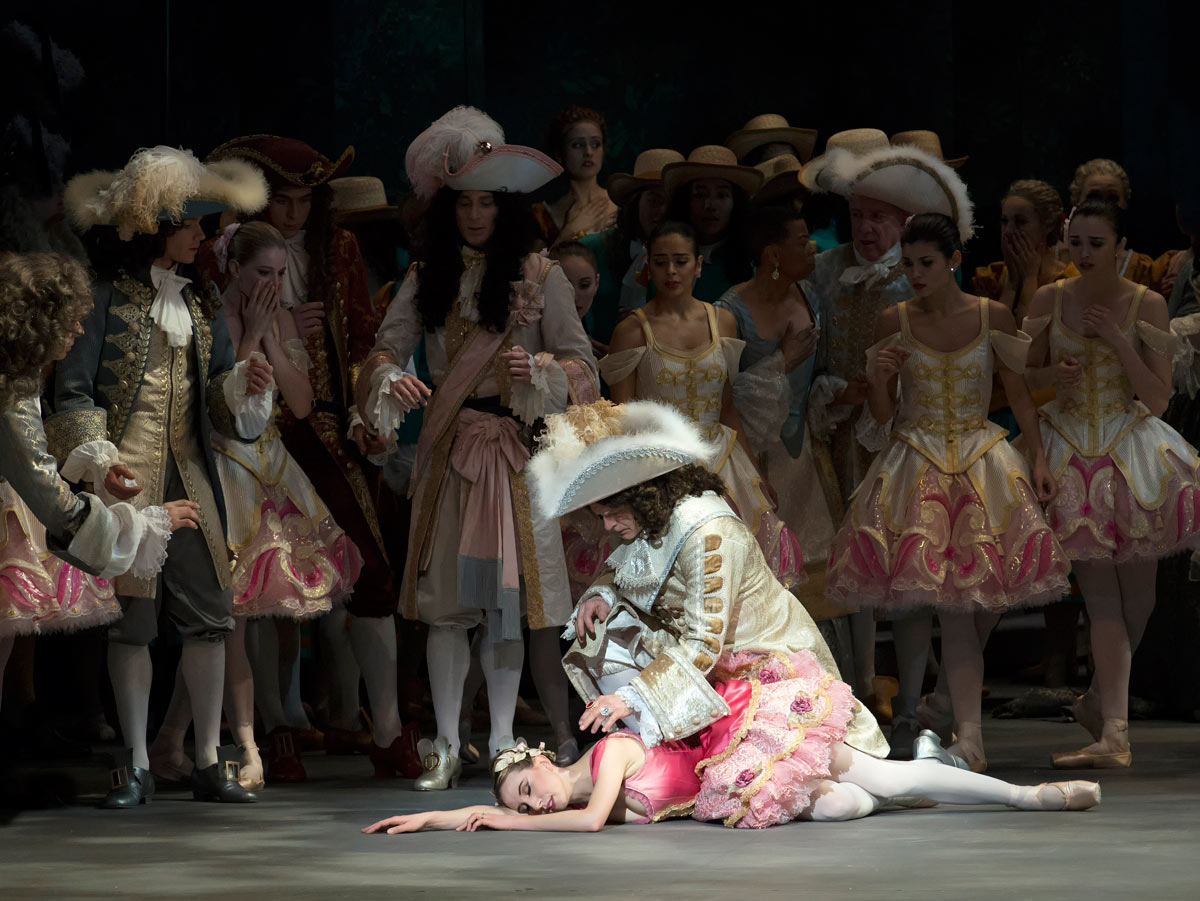
© Gene Schiavone. (Click image for larger version)
To shed light on the mysteries and secrets of the original Sleeping Beauty, Ratmansky conducted extensive library research, studying annotated movement scores (created by Vladimir Stepanov), drawings, photographs and other archival materials at the Harvard Theatre Collection. His numerous discoveries gave this new production its heart and soul.
This Beauty is deeply theatrical. By restoring every piece of pantomime found in the manuscripts, Ratmansky breathes new life into this familiar fairytale and turns the whole story into absorbing drama. Every personage of the ballet is finely drawn and becomes an important part of the plot.
The drama begins to percolate in the opening Prologue as Catalabutte, the King’s Chief Minister, frets over the list of guests invited to the baby Aurora’s christening festivities. He carefully checks the scroll again and again. “Did I forget anyone?” he seems to be asking himself repeatedly, visibly overwhelmed with worry and doubt. To get himself off the hook, he shows the list to the King. “Did we forget anyone?” Their mime is so clear – you can almost hear their conversation. The guest list seems to be fine with His Majesty, but looking at Catalabutte, you feel that he is not completely at ease. Because this scene is so wonderfully acted from the start, its climatic resolution – when the livid Carabosse fumes with displeasure at not being invited to the party and casts her fateful spell on Princess Aurora – makes the Prologue all the more meaningful and dramatically moving. On opening night, Marcelo Gomes donned the hideous wig and black cape of the evil witch and gave a thrilling portrayal of the disgruntled old fairy, imbuing his role with particular relish and pathos.
With this ballet, Ratmansky brings the classical idiom to its historic roots; and the dancing itself – lush, articulate, musical – is the most fascinating aspect of his production. Watching this Sleeping Beauty, one realizes as never before just how much classical ballet has changed over the years: what was gained and what lost in the process. The dancers’ movements look soft, expansive, and relaxed; their upper bodies are pliant, backs supple and arms eloquent throughout. The steps seem to be flowing harmoniously with the music. As a result, we pay closer attention to the music and Tchaikovsky’s score springs to life with new emotional power.

© Gene Schiavone. (Click image for larger version)
On opening night, Isabella Boylston was a radiant and graceful Aurora, perfectly at home with the “new” choreographic style of dancing, with its subtle and unforced movements of the arms and hands as well as the “demure” footwork. In this production, the legs never point to the sky and most of the turns are executed on demi-pointe, making the rotations look softer and faster.
In the famous Rose Adagio scene, her performance was nuanced and assured; and she was all warmth and tenderness in the Vision Scene of the second act, beseeching the Prince to come to her rescue. Soloist Joseph Gorak as Prince Désiré didn’t quite project royal authority; yet he was a courteous partner and his solo variation in the wedding pas de deux of the third act, danced with exquisite precision and speed, was a total delight.
From the assorted fairies of the Prologue, Devon Teuscher (Candide) and Christine Shevchenko (Violente) made the most memorable impression, and the enchanting Stella Abrera was a resolute Lilac Fairy who alleviates the fatal curse of Carabosse and stirs the story to its happy conclusion.
The second cast was blessed with a stately Prince. Marcelo Gomes was a paragon of charisma and charm as Prince Désiré, partnering Hee Seo’s Aurora with meticulous attention and noble manner. As the Princess, Seo was lovely and animated, giving a notable performance of clarity and grace.
Of particular note are the high elevation and pliancy of Zhiyao Zhang in the Bluebird solo and the impeccable comic timing and appealing charm of Katherine Williams as Cinderella and Thomas Forster as her Prince in Act III’s wedding divertissements.

© Gene Schiavone. (Click image for larger version)
This Sleeping Beauty boasts some of the most opulent costumes and decorations (by Richard Hudson) you will ever see on a dance stage. The décor was inspired by the 1921 designs created by Leon Bakst for Serge Diaghilev’s production of Sleeping Princess.
Unlike the ballet itself, some of the fashion choices are not love at first sight. When I saw the production at the Met, in June, I wasn’t particularly thrilled by the oversized wigs and showy gowns which looked more flamboyant than elegant and the color scheme often seemed too loud and plainly wrong. I am still not entirely convinced by the ensemble’s attire for the “Garland Waltz” and the long fringed purple frock of the Lilac Fairy makes me cringe. I would have liked to see Aurora and her Prince in their wedding pas de deux in more elaborate dress (currently their costumes look like “Baroque underwear”). But the overall perception of the stage fashion improves with repeat viewing and, for all their fabulous extravagance, the costumes, however bizarre, become a part of the intrinsic charm of this spectacular Beauty.








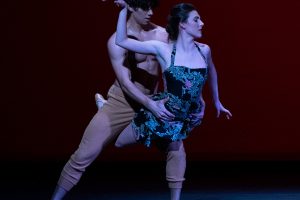
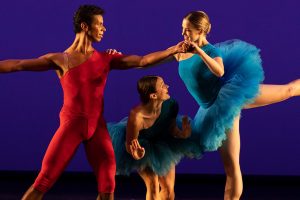
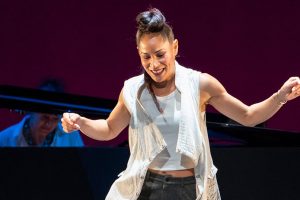
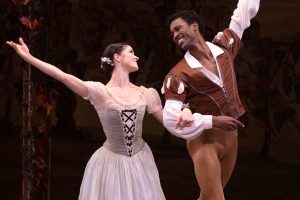
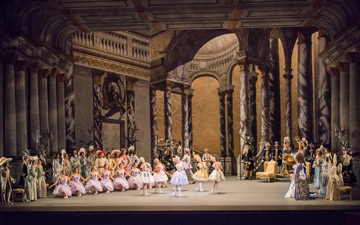

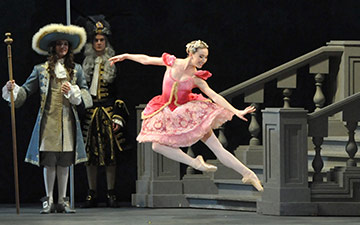
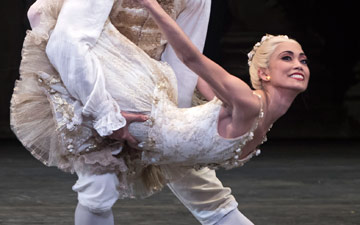
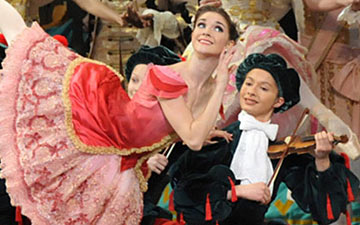
You must be logged in to post a comment.